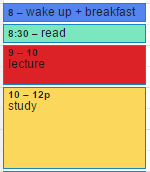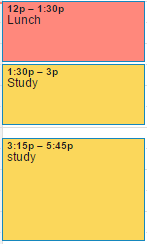There are two easy ways to create feasible plans:
- Pretend you have 30% the energy you usually have
- Copy a plan you’ve completed successfully before
Note that I’ve left out the most obvious way – looking at a calendar and the things you have to do then filling up the hours.
Why don’t we stick to plans?
I’m probably one of the biggest culprit of this which is what led me to figure out how to stop this from happening again as it was becoming a huge source of frustration.
It’s simply too difficult
For some reason, if we imagine a free day we imagine a lot of time. But we also assume our energy levels will match that. It often doesn’t.
Cramming the day with loads of activities is only going to make you tired quickly and far more likely to stop doing them even in the middle of the day. If it’s a long term plan it’s even less likely to continue.
We get distracted
Distractions are a huge problem. As research shows, after a distraction, it takes about 25 minutes to get back into work.
It makes our work far less efficient and moves everything in the plan forward. Therefore we work longer, become more tired and start putting things off.
We don’t give ourselves enough time
We might assume that we can get an essay done in 3 hours but sometimes we might get stuck which means we have to take a longer break. Or we can’t find the book we want.
Same with side projects you might want to do after work/studying. If we expect to do all of them in a minimal time then we’re either going to drop them completely or reduce them drastically and feel guilty about it.
We procrastinate
Looking at a large plan for the day can be intimidating and cause us to procrastinate. Therefore we don’t do anything we aim to. Here’s one simple way to stop it.
Making plans work
- Assume less energy than normal
This point relies on assuming you have less energy than your plan assumes
If we try being superhuman then get intimidated or worn out by our plan, it’s not a useful. On the other hand, if we’re more modest, we have a much easier starting point, procrastination is less likely and we will complete things.
Let’s take one of the plans I’ve had in the past (and I’ve had many):
This is actually a simplified version of a plan I had at one point in my first year of university.
Looking back on it, it’s surprising to think that I considered it then even more surprising is that I was annoyed when I couldn’t complete it! Nearly 9 hours of difficult (and unnecessary!) work I had planned. That’s on top of being social, dealing with chronic pain and you know, trying to not hate books after my first week.
The plan didn’t work for a variety of reasons:
- I didn’t have the energy to complete them
- I ignored other factors (like having friends and going outside)
- It was boring
- It wasn’t flexible
Creating the plan with the mind that you’ll have less energy means you plan to do fewer things, increase flexibility and still complete things. So the plan above might turn into this (assuming there’s a 9am start):

And that’d be it.
The first plan has nearly 9 hours of mentally tasking work while the second has 4 hours with large breaks in between. It’s much easier to start and I found I got more work done with the second plan overall.
- Copy a previous plan.
The second condition is easier to implement. If you’ve successfully created and completed a plan before, copy it and use it again.
However, it’s important to take into account new factors when doing this because your past plan might have been completed under much different conditions. For example, if you’ve caught a cold, your energy is going to be lower than it would be normally so you’ll complete less work or it’ll take longer to complete the same amount.
But remember to be reasonable. If you’ve planned an overnight stay at your library or a general rush till exams, you won’t be able to sustain it for a long period. To combat that, refer to point one.
An impromptu Q&A session
“But you’re doing so little work – you’re obviously doing a Philosophy degree this doesn’t apply to me!”
Fortunately, it still does. If you’ve ever planned anything and never completed it (although you feel you should have) then it applies. Creating unrealistic plans is normal and unless you actually have unlimited energy, it’s fine to plan less and complete more.
Dealing with chronic pain means I’ve had to change how I view plans and making my time more efficient. This is one way I’ve managed to stay with the crowd despite being in pain all the time.
“But what if I can’t plan less! I have so much more work to do than you”
That’s where the second condition comes into place.
Not every plan can work on such little energy. Deadlines and loads of work exist. If you’ve actually completed a plan that meets the demands of your current situation, mould it around that. As Scott Young says, you’re allowed to experiment.
If not, continue to assume you’ll have less energy when creating it. And stop procrastinating.
“What if I have scheduled commitments?”
If you have a variety of things you want to do (clubs, learning new things, blogging etc), reducing the amount of energy you’ll have to complete it seems ridiculous. It isn’t.
In this scenario, you have to exercise prioritising and say no to some commitments. If you don’t, there’s a good chance you won’t do them, get frustrated at the ‘little free time’ you have or burn out very quickly and blame yourself.
Admittedly, it is difficult saying no to things especially when you seem to have a lot of time for trying new things. Those things won’t disappear straight away and there’s no point in planning them if you’re too tired to complete them.
It’s alright to say no.
“Am I allowed to continue working past my smaller plan?”
Yes. A minimal plan makes it easier to start working. It doesn’t necessarily put a limit on how much you should continue working. Though, it should make you more efficient with the hours planned – reducing the need to continue working much more.
The next day, return to the minimal plan. A good plan is sustainable.
“I’m rubbish with times. What if I oversleep?”
Ignore times and focus on activities. Instead of planning the hours, aim to work on a project for an hour in the morning and an hour in the evening.
If that is too difficult, aim to do an hour of the project during the course of the day. The earlier the better of course as you don’t want tiredness to excuse you from working.
“Did you write these questions yourself?”
Some things are best kept secret.
Action Steps
The take away from this is to reduce the amount of energy you’ll need to finish a plan so it’s easier to start and easier to complete.
What can you do now?
- Create a plan for your ideal day
- Assume you’ll have less energy than normal
- Create a new plan.
A small amount of completed work is better than a large amount left wished to be completed.
Sign up to my fortnightly newsletter for free updates on my best posts.



Very useful post! Thanks.
Glad it could help :)
Great research! Thank you! :)
No problem at all. Happy I can help
If you don’t mind it d be awesome if you could check my blog out xp